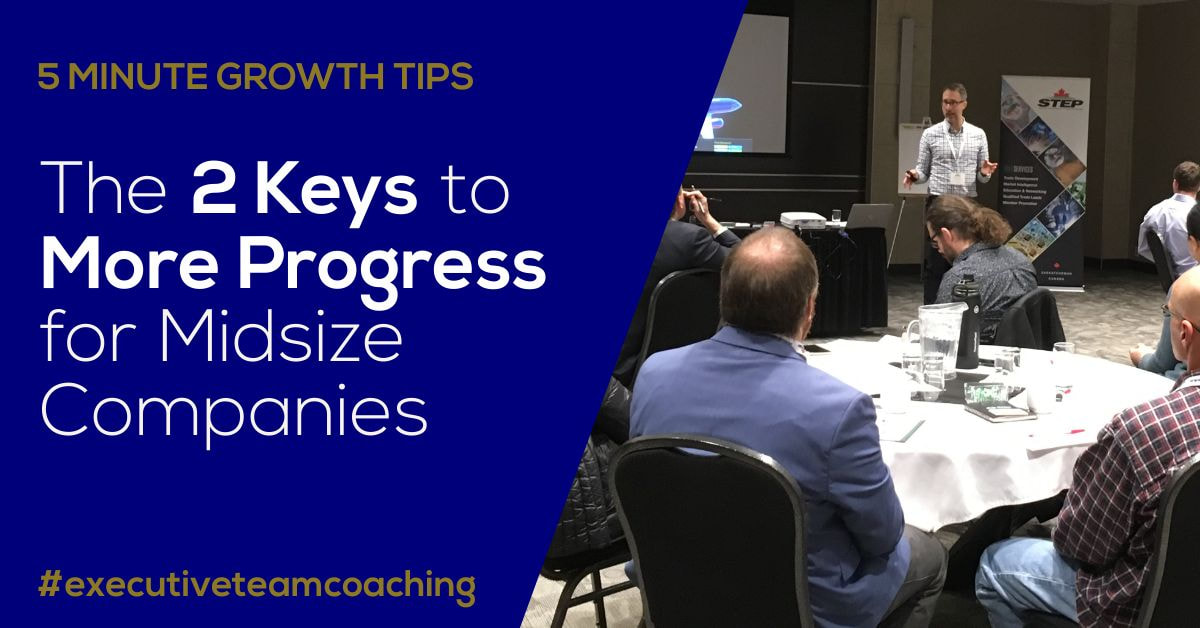|
In the previous 5 Minute Growth Tip article, I shared how companies need to implement structures, processes and systems in order to grow. Without this, they either won’t grow beyond the limits of their current structures, or they will grow inefficiently and increasingly unprofitable.
But as an owner or CEO tries to grow their company to 50, 100 or 200 employees, they may feel like the company is no longer making real progress with those kinds of improvements. Any changes they want to make in their company don’t seem to get done, or don’t get done right. So, how can CEOs increase their momentum? We know that, as a company grows, the CEO increasingly has to get things done through their top team. I covered this also in this previous article. The members of their top team are the ones who need to lead improvement projects within each of their departments and between and across departments. The two keys to making this happen are 1) efficient leadership team buyin, and 2) accountability for execution. Why progress slows with growth When a company is small, less than 10 or 15 employees, it’s more straightforward to get improvement projects done. Often, as CEOs, we just do these projects ourselves. As we begin to delegate these improvement projects, we simply ask a supervisor or front-line employee to get them done. If they are a strong employee, they will usually make it happen. When we have 25, 50 or 100 employees, it gets harder. The reason is what’s called “the power differential”: the difference between the influence of the CEO and the influence of others. In a smaller company, the owner is a strong voice that is heard more easily among the small group of employees. There are often no other voices that are similarly strong (unless of course there is one or more partners involved). It’s also easy to see when someone in a small group is not following through on a project. So each employee has a strong motivation to follow through on the owner’s direction. In a smaller company, there is a large power differential. As the company gets larger, the power differential decreases. As some departments get larger (eg. a production department), the leaders of those departments gain influence. They have now become critical people for the productivity and profitability of the company. The owner no longer has that same strong singular voice. One or more other leaders have strong voices as well. They tend to have more influence about decisions made for the company, and certainly their own department. As well, the owner becomes more detached from the front-line and may feel less confident about what is the right thing to do. The other influential leaders now often have a better perspective on what needs to be done in the operations. This also increases their influence. The owner may therefore feel less influence to be able to simply ask others to take on and carry out improvement projects they dream up. They know they need these high-influence leaders to make things happen. And they may recognize that they lose their leaders' commitment and initiative when they just tell them what to do. The result is that getting leaders to make changes and improvements in and across a mid-size company becomes more challenging than getting front-line employees and supervisors to do so in a smaller company. The trick is in the two keys: 1) efficient leadership team buy-in, and 2) team-based accountability. Efficient Leadership Team Buyin Rather than a CEO figuring out on their own what needs improving and changing for the company, and simply delegating those projects to others, they need to shift to making decisions for the company in collaboration with the members of their top team. This will enable them and their top team members to make company decisions that they’re all committed to. In short, as the saying goes, “people support what they help to create”. This doesn’t mean the CEO doesn’t get the final say. It’s how they get to a final decision that needs to be adjusted. Patrick Lencioni, in his best-selling book, The Five Dysfunctions of a team, called this approach “disagree and commit”. The top team discusses the problem or opportunity and gets all the information out on the table for consideration. Options are discussed and weighed. All members of the top team have the opportunity to share their perspectives and concerns. If an agreement is easily made, then great. If not, the CEO makes the final decision with everyone knowing their perspective has been heard and considered, and agreeing that now is the time to commit to the final decision. This approach allows for effective leadership team participation, while keeping it efficient. This can be a game-changer for CEOs who have already shifted to involving their top team in decision-making, but have gone too far. Their decision-making may have slowed to a crawl, or decisions simply don’t get made, because they and their leadership team members don’t always agree on what’s best. And the CEO isn’t willing to make a final decision for fear that their leaders won’t buy in at all. “Disagree and commit” solves this problem. Accountability for Execution Once there is top team buyin to a decision, how do we ensure accountability for its execution? Buyin is certainly important for accountability. But it’s not enough. Accountability ensures that leaders assigned with taking on certain improvement projects follow through as best as humanly possible. Accountability also means being open and transparent when a project or special effort doesn’t go as planned, so all possible action can be taken to get it back on track. Accountability, also, is more difficult as a company grows. And it’s also due to the changing power differentials. Simply following up one-on-one with individual leaders no longer works as well. Leaders of larger departments have more influence, and their performance is more hidden in a larger company. So there is less pressure to follow through. The solution is again a team approach. Mark Green, a colleague of mine in Virginia, and a peer member of Gravitas Impact Premium Coaches, captured the key ingredients for accountability in his recent monograph titled “Creating a Culture of Accountability”. There are three ingredients for accountability:
Self-accountability is where the CEO, as the leader of the team, leads by example by acting accountably themselves, ensuring they have the right people in the right seats on their leadership team, and raising their expectations of their leaders. Role accountability is about ensuring each leader is clear about their own and each others’ accountabilities. This includes defining the specific results expected for each role and the metrics that make those expectations clear. Note that it’s just as important for leaders to be clear on each others’ roles as their own. This ensures only one person is accountable for each function and everyone is clear on what to expect from others. Process accountability includes communicating about decisions they’ve made in a way that maintains leaders’ natural motivation to execute. This includes believing in their ability to succeed, reminding them why it matters and paying attention to their progress. Process accountability also involves: - ensuring planning happens before action, and on a consistent basis, - having a rhythm of effective and efficient meetings that ensures regular follow-up on progress and results, - and regular one-on-one coaching between the CEO and each leadership team member to develop and support performance. From leading individuals to leading the top team Efficient leadership team buy-in and team-based accountability for execution are the two keys for CEOs to enable continual improvement to grow their mid-size companies. And we can see a common thread for the CEO: shifting from directing individuals to leading and building the top team. This shift can be challenging for CEOs who have become comfortable with a directive style. Yet shifting to leading the top team is critical to getting their leaders bought in, executing, and making more progress. But is it really progress if you’re not going in the right direction? And how do you know if you are? More on that in my next 5 Minute Growth Tip article. How can you increase your momentum? To find out how to make more progress to grow more easily, quickly and profitability, AND enjoy the ride, try our complimentary Agile Growth Checklist. This self-service questionnaire takes 5 to 10 minutes to complete. You'll receive the checklist with your responses immediately. Within 24 hours, you'll receive a compiled report highlighting areas to improve. Complete sections 1 and 4 to check your company’s leadership team and execution processes. Or complete all 7 sections to find out how your company is doing in each of the 7 areas needed to produce more rapid, profitable and sustainable growth. This report is complementary and involves no obligation. Comments are closed.
|
Archives
December 2029
Categories
All
|


 RSS Feed
RSS Feed
